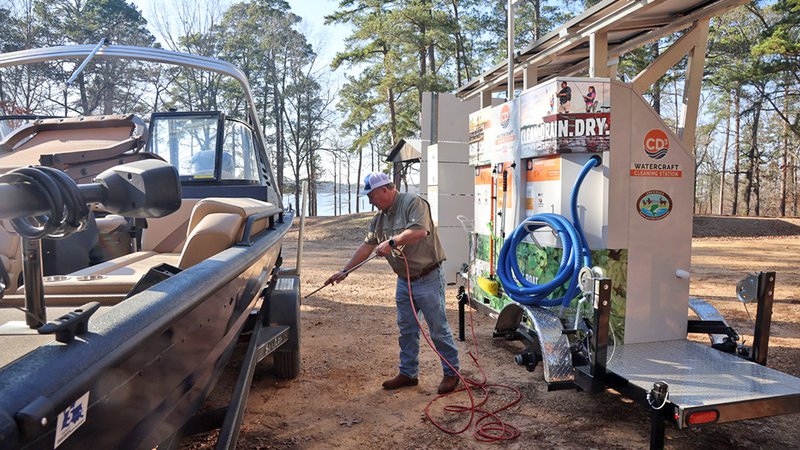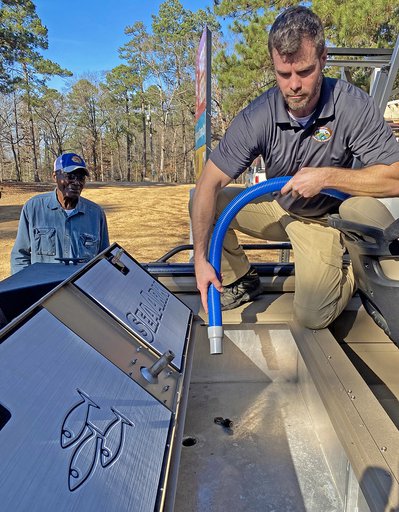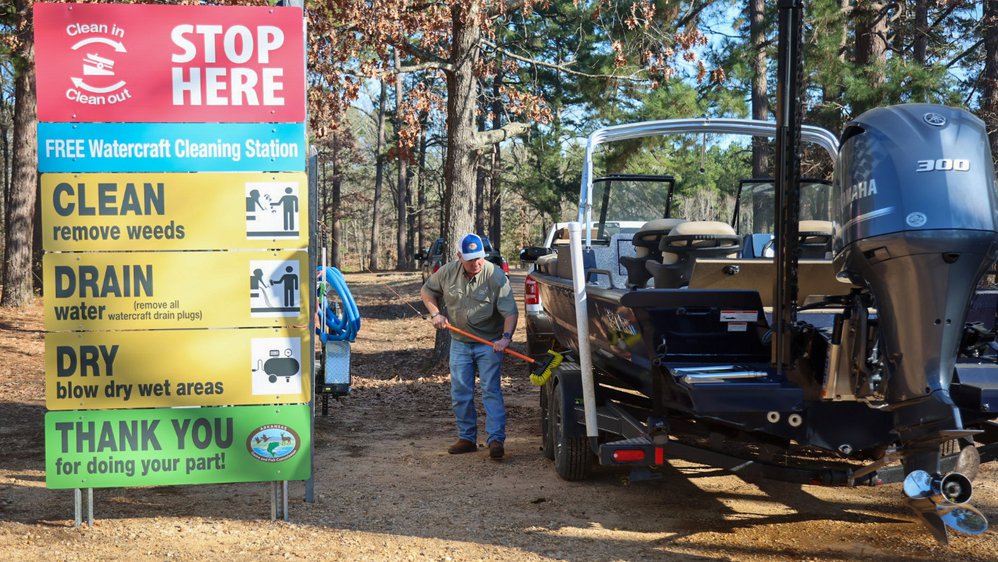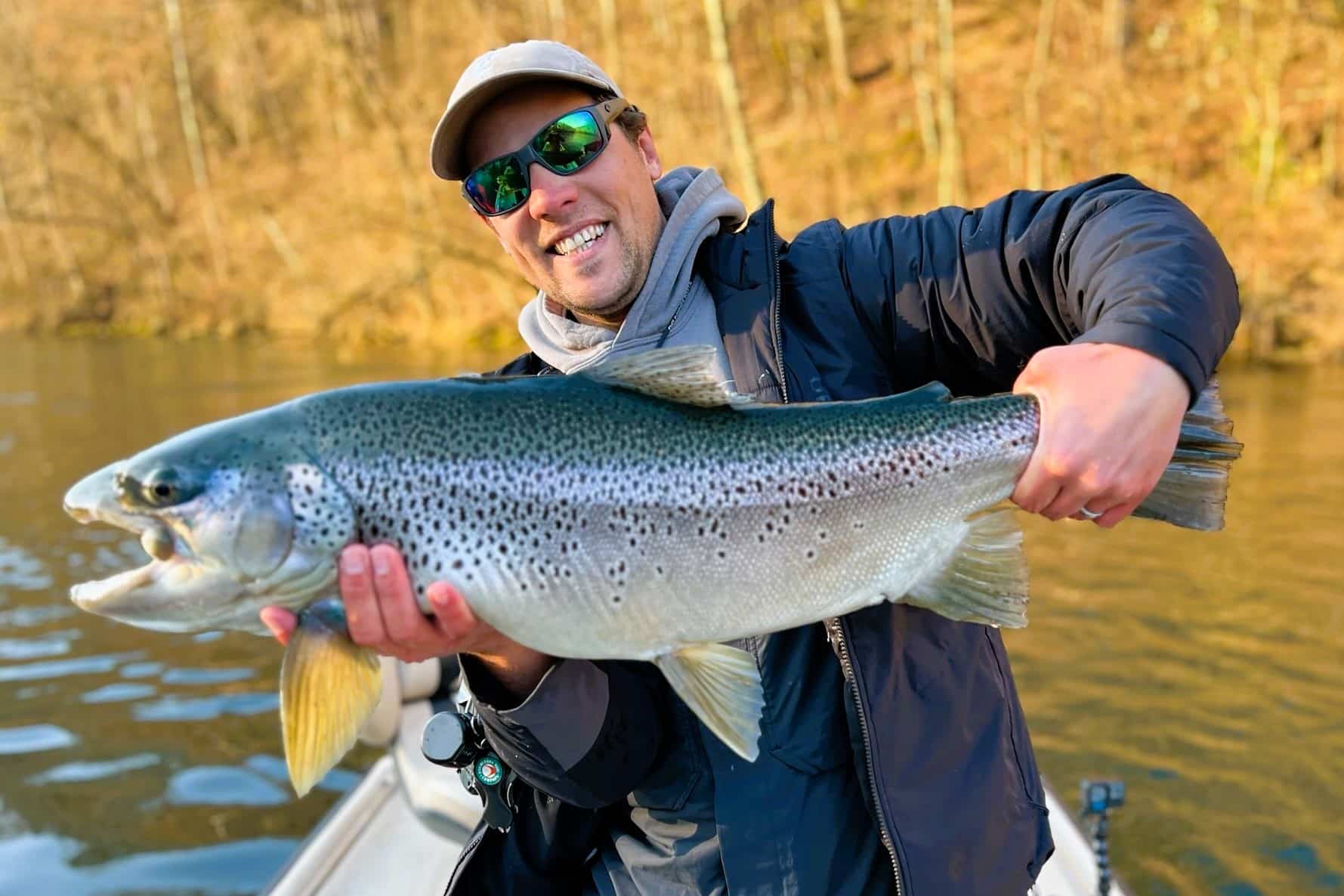AGFC offering anglers the tools to prevent the spread of giant salvinia from Erling
ON 01-11-2023

Jan. 11, 2023
Randy Zellers
Assistant Chief of Communications
TAYLOR — Anglers visiting Lake Erling will find a new cleaning station for their boats at AGRED Park and boat ramp — one designed to help fight the spread of aquatic nuisance species such as giant salvinia, a floating aquatic plant native to South America, considered one of the world’s worst invasive plants, and one the lake owners and AGFC have been fighting since its arrival to the lake in 2018.
The boat ramp is the only free public access to the 7,000-acre crappie and bass fishing hotspot between Hope and Magnolia and is maintained by the American Gamebird Research Education and Development Foundation, the organization that took possession of the lake from International Paper in 2014.
“When the fish are biting, we’ll have 50 or 60 boats a day at that ramp,” Eric Fletcher, president of AGRED, said. “It’s popular with crappie tournaments and we’ll even have the CrappieMasters fish it this June.”
That sort of popularity made AGRED Park and Erling an ideal location for the Arkansas Game and Fish Commission to start this pilot project with installing a free watercraft cleaning station for anglers to clean, drain and dry their boats and trailers to help prevent the spread of giant salvinia and other invasive species.

Matt Horton, Aquatic Nuisance Species Coordinator for the AGFC, said giant salvinia is found throughout Lake Erling and poses a significant threat to Arkansas’s aquatic resources. “We can’t afford for giant salvinia to spread to other waters, so AGFC amended a management agreement with the AGRED foundation last summer to allow AGFC to conduct control and containment activities to prevent the spread of giant salvinia.”
Horton worked with CD3 Systems, a company that specializes in watercraft cleaning stations for invasive species , to purchase a mobile watercraft cleaning station to get anglers more involved in the fight against giant salvinia and other invasive aquatic species.
According to Horton, plants like giant salvinia are most commonly spread by hitching a ride on boats and trailers, and only one sprig of plant matter is all it takes to become established in a new lake.
“We want to be able to give those boaters the means to easily and efficiently clean, drain, and dry their boats after they leave the lake, to help protect our fisheries,” Horton said. “Setting the station up right where anglers are pulling their boats out and offering it for free is one step that can prevent a huge expense down the road.”
Invasive species are a prime example of the old adage, “An ounce of prevention is worth a pound of cure.”
“The state of Louisiana spends millions each year just controlling invasive aquatic plants, and the majority of those efforts are focused on giant salvinia,” Horton said. “We don’t want Arkansas to be in that situation, so we are working to contain giant salvinia in Lakes Erling and Columbia, the only two water bodies where it is found in the state. Money spent on controlling invasive species eats up funds that could be spent on habitat enhancement, stocking and access improvements for our anglers. By cleaning, draining and drying boats and equipment before moving to a new waterbody, anglers and boaters play a huge role in preventing the spread of invasive species that can hinder access and ruin the fisheries they enjoy.”
Tyler Thomsen, district fisheries supervisor in Camden, said the cleaning station does not need an external water and power source, so it can be moved to other locations quickly if another infestation of aquatic nuisance species is found.
“It uses compressed air and vacuum power instead of water, and it has manual tools that can be used as well,” Thomsen said.
According to Horton the system is designed to have enough power to clean up to 100 boats per day, and also has recharging capability from external power sources if need be. The whole rig runs on battery power and has solar panels to recharge the batteries between use.”
The goal is getting anglers to use the station. Instructional signs at the station walk boaters through the process of cleaning their boat, and time-activated lights even enable its use after the sun goes down. Horton is hopeful anglers take this opportunity, “Plus who doesn’t like a clean boat?” Horton said. “If anglers use the cleaning station, data collected can help justify the purchase of more such stations to be placed at other Arkansas lakes.
“States from Louisiana to Minnesota have installed some of these CD3 watercraft-cleaning stations and received some positive response from anglers and significant reductions in aquatic invasive species transportation violations, so we’re really excited to provide our anglers with this useful prevention tool,” Horton said. “AGFC covered the expense for this one, but if it proves itself, we can possibly get federal grants to acquire more of them and look at placing permanent stations at some of our other popular lakes in the state.”
Visit https://www.agfc.com/en/fishing/threats-our-fisheries/aquatic-nuisance-species/ to read more about and learn how to identify giant salvinia and other aquatic nuisance species found in Arkansas. The page also has a link for the public to report observations of invasive aquatic species, to help AGFC respond to new introductions and document species distributions in Arkansas.

Recent News

Arkansas Wildlife Weekly Fishing Report
Apr. 25, 2024
Subscribe to Our Weekly Newsletter E-mails
Don’t miss another issue. Sign up now to receive the AGFC Wildlife Weekly Newsletter in your mailbox every Wednesday afternoon (Waterfowl Reports are published weekly during waterfowl season and periodically outside the season). Fishing Reports arrive on Thursdays. Fill in the following fields and hit submit. Thanks, and welcome!

